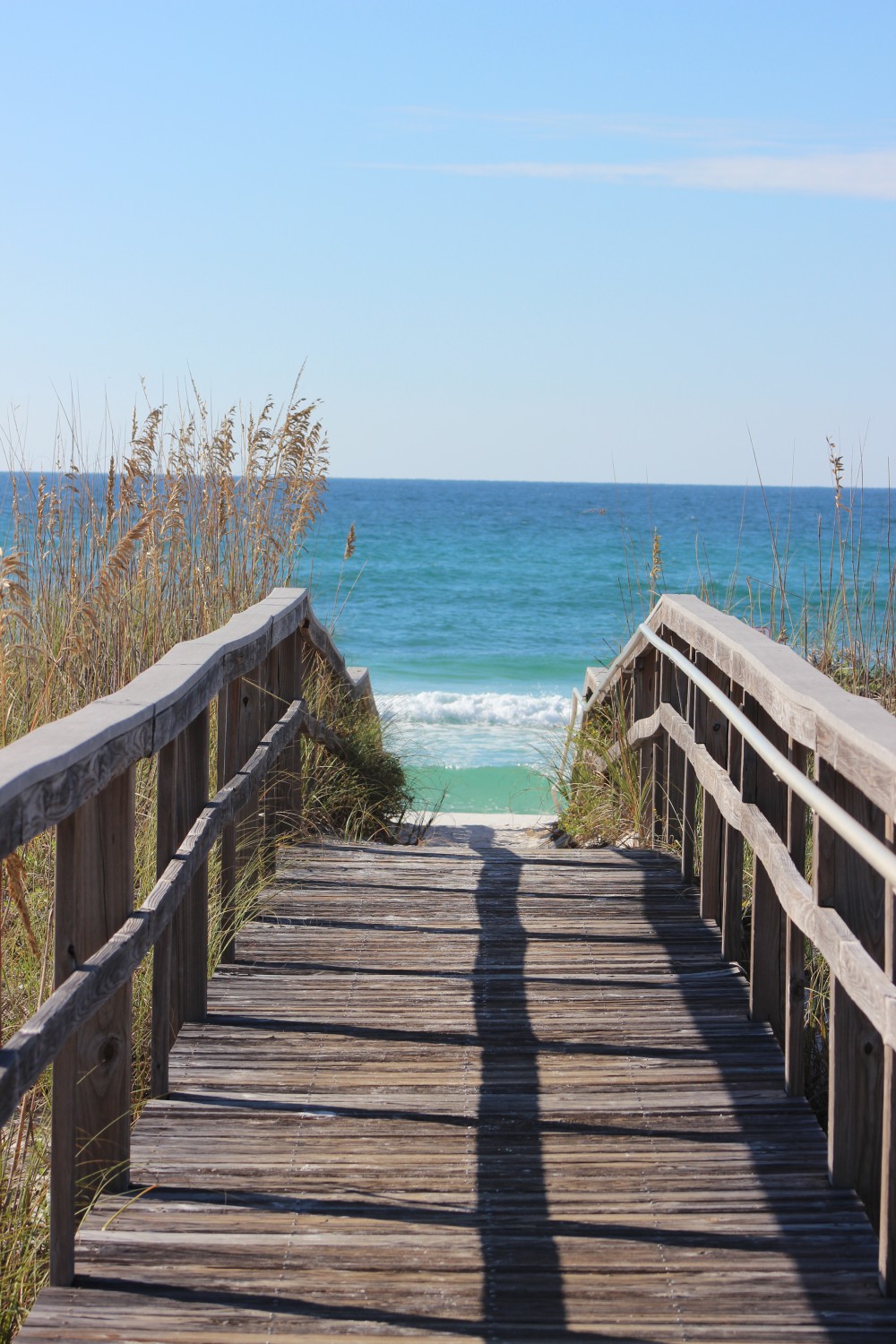
by Rick O'Connor | Sep 19, 2015
I am not going to lie… I skipped August… It was hot…
September however was nice. The day I made the hike the skies were clear and the temperature was 75°F! wonderfully… truly wonderful.
If you are like me you probably begin your day around the same time – and have probably noticed that it is darker when you get up. September 22 is the fall equinox and the length of our day will be exactly 12 hours of daylight and 12 hours of darkness. We then enter the “dark side” of the calendar year – the days will become shorter… and already have. As we move into autumn on our beaches we will notice some changes. One, fewer visitors, but we will also notice changes in wildlife.
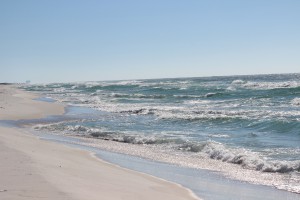
The steep incline of a winter time beach scarp.
Photo: Molly O’Connor
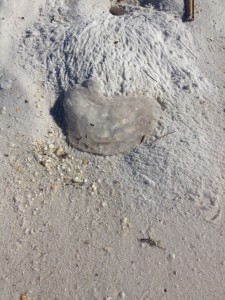
The remnants of moon jellyfish near a ghost crab hole.
Photo: Rick O’Connor
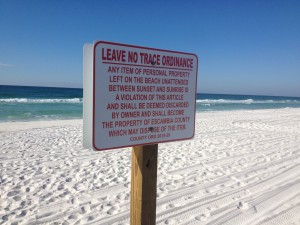
Many counties in the panhandle have lighting and barrier ordinances to protect wildlife and workers.
Photo: Rick O’Connor
As you can see in the photograph the scarp of the shoreline is becoming more pronounced. As the sun begins to spend more time below the horizon the winds shift, the waves change, sand is moved more offshore and the shape of our beach changes as well. You may have noticed the purple safety flags have been flying a lot recently. These mean “dangerous sea life” and we have been seeing a lot of jellyfish as the summer comes to a close. Today I noticed a lot of ghost crab holes. These guys are always around but their presence seems more noticeable this time of year – possibly due to more available food. Over the last six months I have been working with CleanPeace and the Escambia County Division of Marine Resources monitoring marine debris. Our objective is to determine what the major local debris issues are and develop an education program to try and reduce these problems. Cigarette butts have been consistently the #1 item since January. Many of you probably remember the “Keep Your Butt off the Beach” campaign a few years back… apparently did not worked well. We will have to educate locals and visitors to please take their cigarette butts with them. For those in Escambia County you will now notice the new Leave No Trace signs. The Escambia County Board of County Commissioners passed a new ordinance this past month that requires all residents and visitors to remove items from the beach overnight. Not only have these negatively impacted nesting sea turtles they have become a hazard for evening work crews and the general public. Most panhandle counties have some form of “Leave No Trace”. Please help educate everyone about their ordinances.
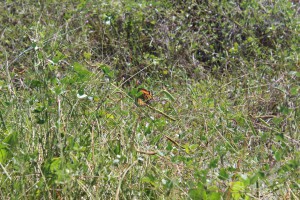
The majestic monarch butterfly stopping along the panhandle on its way to Mexico.
Photo: Molly O’Connor
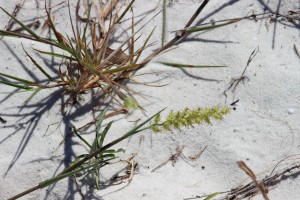
The common sandspur.
Photo: Molly O’Connor
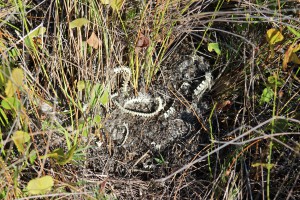
A snake skeleton found near the swale area on the island. Between the primary and secondary dune.
Photo: Molly O’Connor
Fall is the time of the monarch movement. Typically they begin to show in numbers after the equinox but we did see a few on the island this week. Be ready, next month should be full of them. The sandspurs were beginning to develop their spiny seed pods. I would caution all to check their shoes and clothing before leaving the beach this time of year to avoid carrying these seed pods home and distributing them in your yard… uncool.
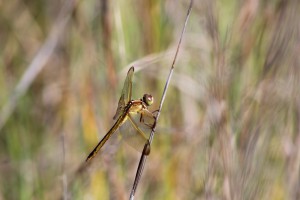
One of the many species of dragonflies that visit our islands.
Photo: Molly O’Connor
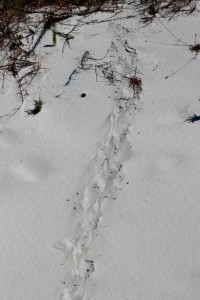
The tracks of the very common armadillo.
Photo: Molly O’Connor
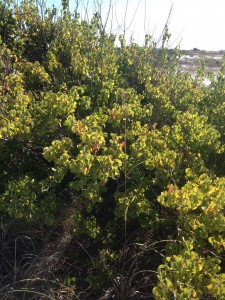
The invasive Chinese Tallow.
Photo: Rick O’Connor
We did see evidence of snake movement this week. There are several species, including the Eastern Diamondback Rattler, which will breed in the fall as well as the spring. I expect to see more activity as the days grow shorter. The dragonflies were very active this month. Actually my wife witnessed two of them consistently pestering a monarch butterfly until the butterfly moved away. I have seen armadillo activity every month of the year so far, this month was no different. The islands seem full of them. This lone Chinese Tallow has formed a small dune where other plants have established and many creatures have taken up residence. At this time there are no other Tallow in the area, and this one will need to be removed before the spread begins. But it is an interesting paradox in that there was an armadillo burrow found here and the sea oats have utilized this dune as well. Invasive species are a problem throughout the state and many have caused with economic or environmental problems – or both! Though this tree has participated in establishing a much needed dune on our hurricane beaten island – native plants do the same and should be favored over non-native. We will have to remove this tree.
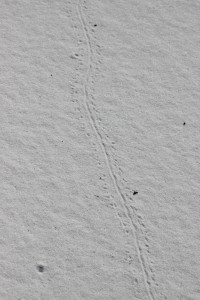
An unknown track; possibly of a turtle hatching.
Photo: Molly O’Connor
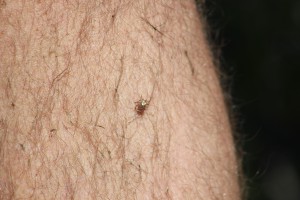
This tick was a hitchhiker on our trip through the dunes.
Photo: Molly O’Connor
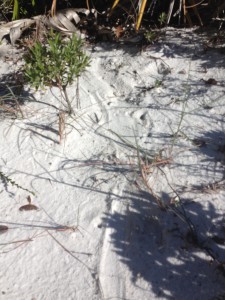
This track was found in the tertiary dune system and could be an adult turtle.
Photo: Rick O’Connor
This small track has the appearance of a “turtle crawl”. It certainly is not a sea turtle, in the middle of the dune field for one thing, but there are several freshwater ponds on our islands that harbor a variety of “riverine turtles”. I know that Cooters, Sliders, and Snappers live on Santa Rosa Island. Terrapins are found in salt marshes. Not sure if this is a turtle but all should be aware that now is hatching time. Many turtle nests began hatching about a month ago and young turtles can be found in a lot of locations. The track in this picture is from a very small animal.
Ticks… yep ticks… It is hard to do a lot of fun outdoor activity in the southeast without encountering these guys. They like to sit on top of tall grass and wait for a mammal to come rummaging through. After each hike we always do a “tick check”. I typically wash my hiking clothes AS SOON AS I GET HOME – in case they are harboring within… I would recommend you do the same. We have been following the “mystery track” since January. This “bed” we have seen each month is in the same location. I thought I had solved the mystery in July when I found armadillo tracks all around it but this month suggest this is not an armadillo. We are not sure what it is – we are leaning towards alligator or otter (both of which can be found – and have been found – on our islands). We will continue to monitor this and hopefully find the sculptor.
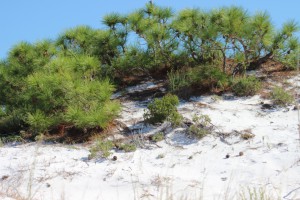
The top of a pine tree within a tertiary dune.
Photo: Molly O’Connor
The seagrass in the sound looked very thick and healthy this month. I have seen horseshoe crab here over the summer and Sea Grant conducted a scallop survey in Santa Rosa Sound and Big Lagoon within Santa Rosa and Escambia counties in August. We found no live scallop but plenty of dead ones – and some of that shell material was relatively “new”. Since scallops only live a year or two this is a good sign. There has been plenty of anecdotal evidence of live ones in the area. REMEMBER THAT IT IS ILLEGAL TO HARVEST SCALLOP WEST OF PORT ST. JOE AND ONLY FROM JUNE 27 TO SEPTEMBER 24 (Learn More). We will continue to conduct these surveys each summer to determine if our area would be a good candidate for a scallop restoration project.
As the days shorten and cool – I am expecting more wildlife activity to begin. Until next month.

by Rick O'Connor | Sep 12, 2015
In the final segment of this 3 part series on worms we will discuss the largest, most commonly encountered members of the worm world… the Annelids.

Neredia are one of the more common polychaete worms.
Photo: University of California Berkley
Annelids differ from the other two groups of worms we have discussed in that they have segmented bodies. They are largest of the worms and the most anatomically complexed. The fluids of their coelomic cavity serve as a skeleton which supports muscle movement and increases locomotion. The annelids include marine forms called Polychaetes, the earthworms, and the leeches.
POLYCHAETES
Polychaetes are the most diverse group of annelids and most live in the marine environment. They differ from earthworms and leeches in that they have appendages called parapodia and do not possess a clitellum. In size they range from 1 mm (0.04”) to 3 m (10’) but most are around 10 cm (4”). Many species display beautiful coloration and some possess toxic spines.
There are 3 basic life forms of polychaetes; free-swimming, sedentary, and boring. The free-swimming polychaetes are found swimming in the water column, crawling across the seabed, or burrowing beneath the sediments. Some species are responsible for the “volcanoes” people see when exploring the bottom of our local bays. Most sedentary polychaetes produce tubes within which they live. Some tubes are made of elastic organic material and others are hard, stony, and calcareous. “Tubeworms” rarely leave their tubes but extend appendages from the tube to collect their food. Most feed on organic material either in the water column or on the seabed but some species collect and consume small invertebrates. There are commensal polychaetes but parasitism is rare. All polychaetes have gills and a closed circulatory system and some have a small heart. As with the other Annelids, polychaetes do have a small brain and are aware of light, touch, and smell; most species dislike light. Reproduction involves males and females who release their gametes in the water where fertilization occurs and drifting larva form.
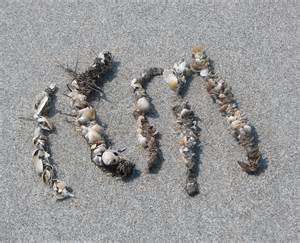
The tube of a common tubeworm found on panhandle beaches; Diopatra.
Photo: University of Michigan
EARTHWORMS
Aside from parasitic tapeworms and leeches, earthworms are one of the more commonly recognized varieties of worms. Many folks actually raise earthworms for their gardens or for fish bait; a process known as vermiculture. Earthworms differ from polychaetes in that they do not have parapodia but DO possess a clitellum, which is used in reproduction. Though most live in the upper layers of the soil there are freshwater species within this group. They are found in all soils, except those in deserts, and can number over 700 individuals / m2. The number of earthworms within the soil is dependent on several factures including the amount of organic matter, the amount of moisture, soil texture, and soil pH. Scientists are not sure why earthworms surface during heavy rains but it has been suggested that the heavy drops hitting the ground can generate vibrations similar to those of an approaching mole; a reason many think “fiddling” for worms works. Earthworms can significantly improve soil conditions by consuming soil and adding organics via their waste, or castings. Unlike polychaetes, earthworms lack gills and take in oxygen through their skin, one reason why they most live in moist soils. Another difference between them and polychaetes is in reproduction. Aquatic polychaetes can release their gametes into the water where they are fertilized but terrestrial earthworms cannot do this. Instead two worms will entangle and exchange gametes; there are no male and females in this group. The fertilized eggs are encased in a mucous cocoon secreted by the clitellum.
LEECHES
Here is another creepy worm… leeches. Leeches are segmented, and thus annelids, and like earthworms they lack the parapodia found in polychaetes and possess a clitellum for reproduction. Most leeches are quite small, 5 cm (2”) but there is one from the Amazon that reaches 30 cm (12”). Most are very colorful and mimic items within the water, such as leaves. They differ from earthworms in that they are flatter and actually lack a complete coelomic cavity; which most annelids do have. They also possess “suckers” at the head and tail ends.
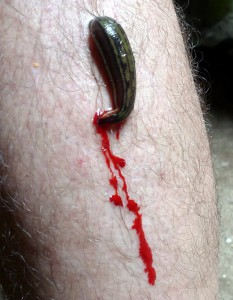
The ectoparasite we all call the leech.
Photo: University of Michigan
Leeches prefer calm, shallow water but are not fans low pH tannic rivers. If conditions are favorable their numbers can be quite high, as many as 10,000 / m2. They are found worldwide but are more common in the northern temperate zones of the planet; North America and Europe.
Some species feed by using an extending proboscis which they insert and remove body fluids, but most actually have jaws with teeth and use them to rip flesh to cause bleeding, cutting as frequently as 2 slices/second. Those with teeth possess an anesthesia that numbs the area where the bite occurs. Both those with and without teeth possess hirudin, which is an anticoagulant, allowing free-bleeding until the worm is full. Those who feed on blood tend to prey on vertebrates and most species are specific to a particular type of vertebrate. It is known they can detect the smell of a human and will actually swim towards one who is standing still in the water. It takes several hundred days for a leech to digest a full meal of blood and so they feed only once or twice a year. They remove most of the water from the blood once they swallow and require the assistance of bacteria in their guts to breakdown the proteins. They can detect day and night, and prefer to hide from the light. However when it is feeding time they are actually attracted to daylight to increase their chance of finding a host. Vibrations, scent, even water temperature (signaling the presence of warm blooded animals) can stimulate a leech to move towards a potential prey. Leeches, like earthworms, reproduce using a clitellum and develop a cocoon.
Though most find worms a disgusting group of creatures to be avoided, they are actually very successful animals and many species are beneficial to our environment. We hope you learned something from this series and will try and learn more.
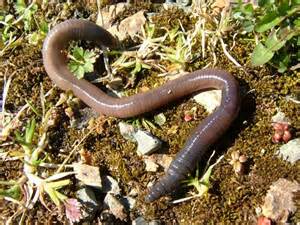
by Rick O'Connor | Aug 21, 2015
I am afraid worms are not the most pleasant topic to write about but few people know much about them. I was once told when I was a student that if you wanted to become known as a scientist study worms, no one else is.
When we hear the term “worm” negative things enter our minds: parasites, disease, uncleanliness to name a few, but many worms are actually beneficial by removing detritus (decaying organic matter) from the environment; the garbage cleaners in a sense. There are at least 10 phyla of worms but this series will focus on the three major groups; flatworms, roundworms, and segmented worms.
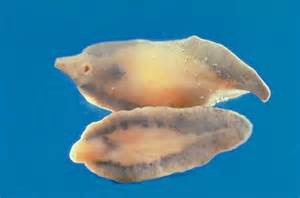
The human liver fluke. One of the trematod flatworms that are parasitic.
Photo: University of Pennsylvania
Flatworms include three classes and two of those are parasitic; those are the flukes and tapeworms. Most are very small and emerge in low or no light. The parasitic forms typically live in the gut but can infest other organs of their host organism. There are several species that infest humans but most are specific to a particular group of animals. The flatness of their bodies may have to do with moving materials in and out of the body. Most flatworms lack well develop organ systems so gas exchange occurs through the skin. The more the flat they are, the more surface area they have, the more gas exchange can occur. This is supported by the fact that the larger the flatworm is the more flat they are.
Tubellarians are basically non-parasitic flatworms and are mostly aquatic, many living in the marine environment. Some crawl across the seabed but others can actually swim. As with other flatworms, their digestive tract is incomplete (meaning there is only one opening – the mouth – where food comes in and waste goes out), and this mouth is located half way down their body on the ventral side. Most of these flatworms are carnivorous feeding on small invertebrates and dead organisms. They do have “eyespots” which do not form images but can detect light. Most flatworms are what we call “negatively phototaxic” meaning they sense light but do not like it and will burrow or hide when the sun rises.
Trematoda are what we call flukes and are parasitic. Most are only a few centimeters long but some can reach a meter (3ft.) or more! Flukes have a protective covering on their skin to protect them from the enzymes of their host’s internal environment. Their life cycle requires a second host, meaning that the adult lives in one type of animal but the larval stage occurs in another. Adult flukes live in vertebrates (typically fish), and the secondary hosts are usually invertebrates (typically snails). The eggs (cyst) produced by the adults leave the host organism through their feces. Once in the environment the secondary host consumes them where the larva develop. Eventually the secondary host is consumed by the primary host (fish) where the larva develop into an adult and the cycle begins again. They typically infest the gut but can infest other organs as well.
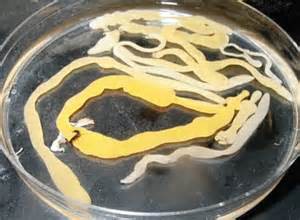
A tapeworm actually has a round head which posses hooks to attach to the lining of the gut.
Photo: University of Nebraska Omaha
Cestods are one of the more recognized flatworms; these are the tapeworms. Tapeworms lack a digestive tract and most absorb all of their nutrients on through their flat bodies. Like their fluke cousins, tapeworms are endoparasites but almost all of them infest the digestive tract. Like their fluke cousins they require a secondary host, usually an arthropod (insect, spider, or crustacean). With a vertebrate serving as the host organism.
Though there are flukes and tapeworms that infest humans most are found in fish and are specific to that group. The ones that do infest humans require the secondary host cycle described above and, because of sanitary conditions we live in, are not commonly found in the population. This cannot be said for parts of the world where sanitary conditions are not to our standards. As horrible as parasites sound many species of nonparasitic flatworms are beneficial by removing detritus from lakes, rivers, and bays.
Next week… Roundworms.
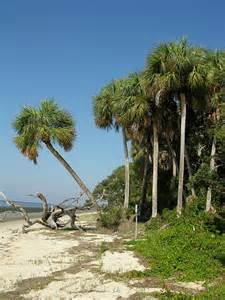
by Rick O'Connor | Aug 7, 2015
First let me explain that Seahorse Key is not in the Florida Panhandle but the story is interesting and a similar phenomena could occur here. Seahorse Key is an isolated island 3.6 miles southwest of Cedar Key in Florida’s Big Bend. There is a science lab owned and maintained by the University of Florida and Captain Kenny McCain on the island but can only reached by boat. Many forms of wildlife, particularly birds, seek out these isolate islands for nesting due to the lack of predators; and Seahorse Key is no exception. Another interesting point about this island is that it may have the highest density of cottonmouths in the state. Dr. Coleman Sheehy has been studying this population and estimates that there may be about 600 cottonmouths on the island. So what is the mystery?
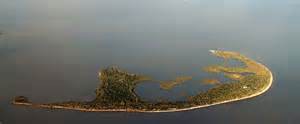
Seahorse Key. An isolated island near Cedar Key
Photo: FMSEA
Well we will first look back to last year and the nesting habits of the island’s birds. In 2014 Vic Doig of the U.S. Fish and Wildlife Service had logged seven different species of egrets, herons, cormorants, pelicans, and ibis nesting on the island. The number of nest per species varied from 100 to 5,000 with the white ibis producing the highest number. Dr. Sheehy surveys the cottonmouths by walking the shoreline and counting the number of snakes he encounters; which is typically around 30. The snakes and nesting birds are concentrated near Gardiners Point. Though the cottonmouths feed on rats they seem to rely on the fish that fall from the nests above.
As 2015 began the biologists noticed something different right off the bat. Though the birds were returning they were not returning in typical numbers, particularly the white ibis. These birds normally are the most abundant nesters on the island, but not this year. Dr. Peter Frederick, University of Florida’s Department of Wildlife Ecology and Conservation, did not seemed to alarmed by this knowing that white ibis are nomadic and do not stick with the same nesting locations for more than a few years. They tend to go where the food is most abundant. No mystery here… Then it happened…
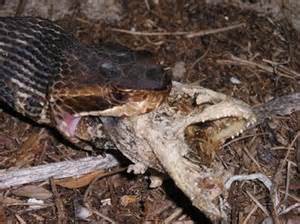
A cottonmouth consuming a fish from a birds nest.
Photo: University of Florida
Within a very short period of time, during the second week of April, all of the other birds began to leave. Researchers found the nests falling apart, no eggs or chicks within them, and hundreds of eggs on the ground. They also found the remains of 26 dead birds in the area. Where had they gone? What had happen?
Autopsied birds found no consistent cause of death. Most of the eggs on the ground had small holes indicating they were preyed upon by birds, most probably fish crows. However these birds are more opportunistic scavengers and would have fed on the eggs only after they had fallen from the nests. Researchers then discovered that many of the birds had relocated to nearby Snake Key. Though they had begun nesting there, fewer than half had done so. All seven species were found there but the number of nests had dropped from 100 – 5,000 to 50 – 600. Many of the birds were still missing. Where did they go? Better yet, why was Snake Key selected and Seahorse abandoned? And did the exodus of birds from Seahorse impact the snakes? The answer is… Yes. Dr. Sheehy’s survey found that the number of snakes encountered along the forest edge had dropped from 30 to 10. He noticed these snakes were thinner and he observed one cottonmouth consuming another, something he had not noticed before. The snakes had been impacted by the decline in nesting birds. What had happened on Seahorse Key?
One idea was put forth by Dr. Sheehy. He had noticed an increase in the number of raccoons on the island. Again, these isolated islands are selected for by nesting birds because of the lack of such predators and Dr. Harvey Lillywhite indicated that the typical number of raccoons on the island is zero. But Dr. Sheehy and Captain McCain had trapped and relocated seven raccoons earlier this summer. This suggests that a large group (large for this island) had found their way to Seahorse Key. Dr. Sheehy suggests that the cause of the movement of birds were the raccoons. There is no evidence of them attacking the birds but they believe the shear presence of the animals was enough for the birds to relocate. However Dr. Fredrick points out that (a) there was little evidence of the raccoons preying on the fallen eggs and (b) he could not find track or scat evidence of more than one or two raccoons on the island during his initial survey after the birds left. He is not so sure the raccoons were the cause.
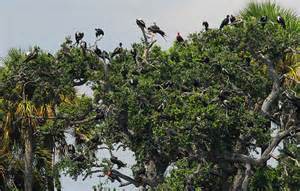
Nesting birds on Seahorse Key
Photo: courtesy of flickr
Then there is the question… Where did the seven raccoons trapped come from? One suggestion was that they were released by locals. This was based on the fact that raccoons captured were well fed and had a mild temperament, not what you typically encounter with trapped raccoons from the wild. Later there was a confirmed report of a local who does take in orphaned raccoons, raises them, and releases them; they could have released some on Seahorse Key – but this has not been confirmed.
So right now this mystery remains unsolved. But the story does indicate the types of problems that can occur when humans relocate animals to habitats they do not typically live in. It takes years for Mother Nature to develop a balance only to have it quickly fall apart by the human release of animals we wish to move or that we think will do better in another location.
You can read more on this story at:
http://fieldguide.blogs.gainesville.com/427/amysteryatseahorsekey/
http://fieldguide.blogs.gainesville.com/450/a-mystery-at-seahorse-key-part-2/
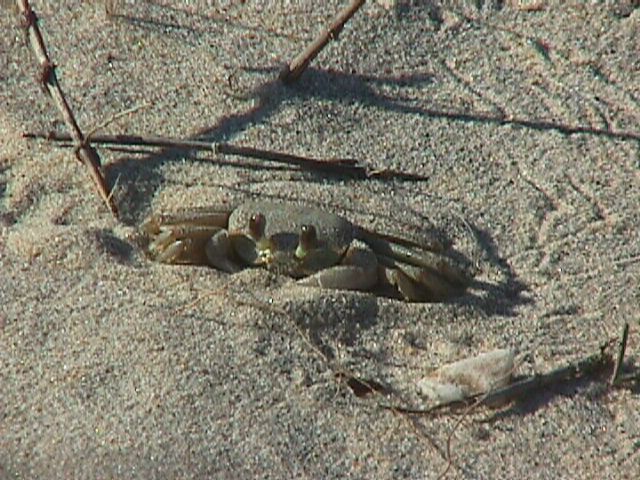
by Rick O'Connor | Jul 31, 2015
For locals along the coast ghost crabs are as common as mockingbirds and mourning doves. Before Ivan, when the dunes were larger and closer to the road, viewing the white crabs scouring across the road at night in your headlights forced all into defensive driving maneuvers. And for those who have ever tried to catch one, all would agree it is one of the fastest animals on the beach.
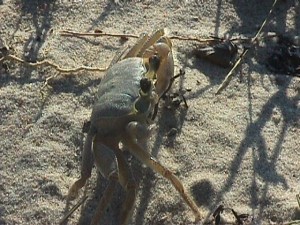
The common ghost crab. Photo: Virginia Institute of Marine Sciences
Ghost crabs (Ocypode quadrata) are members of the fiddler crab family. Like their fiddler crab cousins, they are more terrestrial than aquatic and dig burrows to protect themselves from predators and the intense heat of the midday sun. Though ghost crabs can be found in a variety of locations on the island, they are most frequently found between the mean high tide line and the upper portions of the primary dune line; typically on the Gulf side. Their “J” shaped burrows reach the water level below the sand and can run as deep as four feet. Larger individuals can dig deeper burrows and are often found further away from the water’s edge. These are crabs and thus still possess gills. Gills must be in contact with water in order to obtain needed oxygen. To do this ghost crabs have a gill chamber that will hold water for periods of time. The crabs can obtain water either at the bottom of their burrow or by running to the edge of the Gulf. And running is a good term for what they do. Once they have left the burrow they will lift five of their 10 legs above their head running on the remaining five. Running sideways they will have three in contact with ground in the direction they are going and two on the opposite side; if you look closely you can actually the remaining legs raised high in the air. When they tire, they will stop, make a 180° turn, and begin running again; resting their legs. They have reached speeds of 1.6 meters/second, which is 3.5 mph!
Ghost crabs are most active at night, though they are found at dawn and dusk and occasionally at midday. They feed on invertebrates at the surface zone such as mole crabs (sand fleas) and coquinas (bean clams). Dead fish and other animals found along the shoreline are also part of their diet, often dragging them back to their burrow. Unfortunately they are one of the predators of sea turtle hatchlings heading to the Gulf at night. Ghost crabs breed in late spring and early fall. The females will carry her developed eggs to the surf zone to release them. The developing young will return the following spring to mate and release their own eggs. Females may produce eggs in their second year but rarely live to do the same the third year. They are quite social with other crabs communicating, like their fiddler crab cousins, with body postures and claw movements. They are most active from March to December, plugging the entrance of their burrows and going dormant during the colder months of the year.
There has been concern about the impact of the oil spill on their numbers and the numbers of their prey, mole crabs and coquina. Our beaches did have small and large patches of oil that seeped down into the sand and then there were the methods used to remove the oil from the beach. At this point we do not know how hard their populations were impacted but scientists have collected data before and after the spill and are analyzing this now. However low their population dropped I am sure these resilient creatures will rebound and we will once again dodge them during our evening drives.
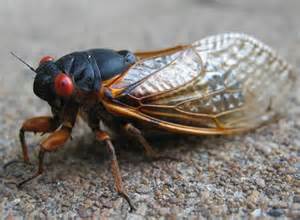
by Rick O'Connor | Jul 24, 2015
I was sitting on my back porch late in the afternoon this past week enjoying the breeze and the sunset when the familiar sound of the bugs some call “locust” began their buzzing songs. Not all would agree with me but I really enjoy the sound of these animals. They remind me of camping and warm summer evenings, they remind me of living in Florida. They have been with me all of my life and I quite enjoy hearing them – would actually miss them if there were not here.
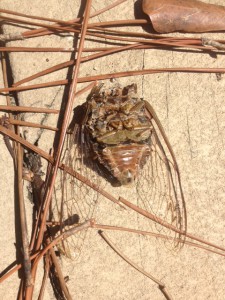
The adult body of a local cicada.
These bugs are not locust but a type of insect called cicadas, which is different from the “katydid” which is a different insect all together. Many who have grown up in Northwest Florida are quite familiar with their songs but not with the insect itself. Cicadas begin their lives in the trees – this is where the females lay their eggs. Most of them will find a split or tear in the twig tissue but others will actually make such a tear and here deposit their eggs. When they hatch they fall to the ground as an ant-sized larva. These larva burrow under the ground and move via burrows feeding on the sap and tissue of plant roots. Some species spend 2 years here, others as many as 17 years before they emerge. Like all members of Arthropoda these insects have external skeletons and must molt, or shed them, as they grow. Cicadas molt three times while living beneath the soil before emerging as a nymph. The nymph will climb a tree where they will molt once more becoming the winged adult some of us have seen. Many have found the empty cast of these molting nymphs clinging to the side of the tree. The males do most of the “singing” using drum-like structures called TIMBALS along their abdomen. These timbals are controlled by muscles and vary from species to species. The songs are species specific and are used to communicate with others but particularly the females, with whom he wishes to breed with before their lives come to an end in a few weeks. Landscapers and contractors have claimed that the sounds of their lawn equipment and power tools will sometimes attract cicadas and there is some evidence that it in fact it does… particularly females.
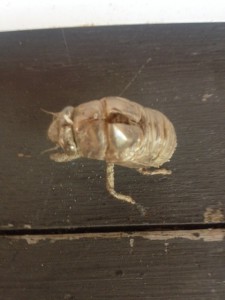
The empty molt of a cicada nymph.
There are many species of cicadas in the United States. One group will lay their eggs, the larva will drop and remain subterranean for 17 years emerging all at once! There are 19 species found in Florida and the mass emergence does not occur here. Our adults emerge every season, singing their songs, and relaxing our souls. I am glad they are here. Enjoy the summer.






























